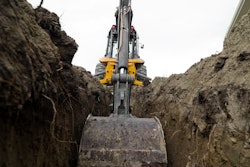Ground-penetrating radar, originally developed for locating underground structures for construction, is finding a sobering new use in emergency recovery efforts.
Monday’s powerful mudslide in La Conchita, Calif. is one such incident where GPR is being used in addition to trained dogs and cameras. That incident killed seven adults and three girls and has possibly buried three people alive, according to the Ventura County Sheriff’s department.
The technology was also used in recovery operations in the aftermath of the World Trade Center terrorist attacks of Sept. 11, 2001.
“GPR can really narrow down the search,” said Ron Laburca, president of Subsurface Imaging Systems. “[Many times] it’s just another tool for the recovery.”
Laburca said if there were a house buried by a mudslide, there would be a “good chance” of finding it with GPR. “In mudslides, it’s worth a shot,” he said.
GPR works by sending pulses of electrical energy into the ground, and collecting information about its resulting echo. By moving the radar across the surface, an image is created in a similar fashion to ultrasound. The time taken for the signal to travel from the GPR to the object and back represents its depth.
Rescue workers can find buried victims by looking for characteristics such as length and width. “That’s really the only way,” Laburca said.
Subsurface Imaging Systems produces small, lightweight GPR devices that can survey large areas quickly and maneuver easily in confined spaces.
Laburca said his company was developing an adaptation of its current technology to better suit emergency recovery purposes. Plans for this application began after Laburca was contracted by the federal government to help survey Ground Zero two days after Sept. 11.
“It was tear-jerking work,” Laburca said. Though he wasn’t able to disclose details of the new technology due to the nature of its release, Laburca said it could revolutionize the way search efforts are undertaken.
The company’s technology was first created for military application. During the early ’80s, GPR was used in the Falklands Conflict to locate plastic landmines. Shortly after its military deployment, the technology was used to solve a British murder case by locating buried bodies.
“We’ve done very well finding crime victims,” Laburca said.
Subsurface Imaging Systems is one of several companies producing GPR products. Mala GeoScience, a Swedish company developing GPR technology with similar applications, also participated in Sept. 11 recovery efforts.
Mala GeoScience claims to be able to show within a centimeter where underground services — utility lines, pipes and other materials — are located. The company also works with scientific applications such as geologic mapping, ice and snow measuring, environmental and archaeological investigations and bore hole examinations.
Mala GeoScience Managing Director Tommy Leijon said the company is moving strongly towards more commercial applications.
“There is a growing interest for our technology,” he said.
Patrick Beeson can be contacted at [email protected].






